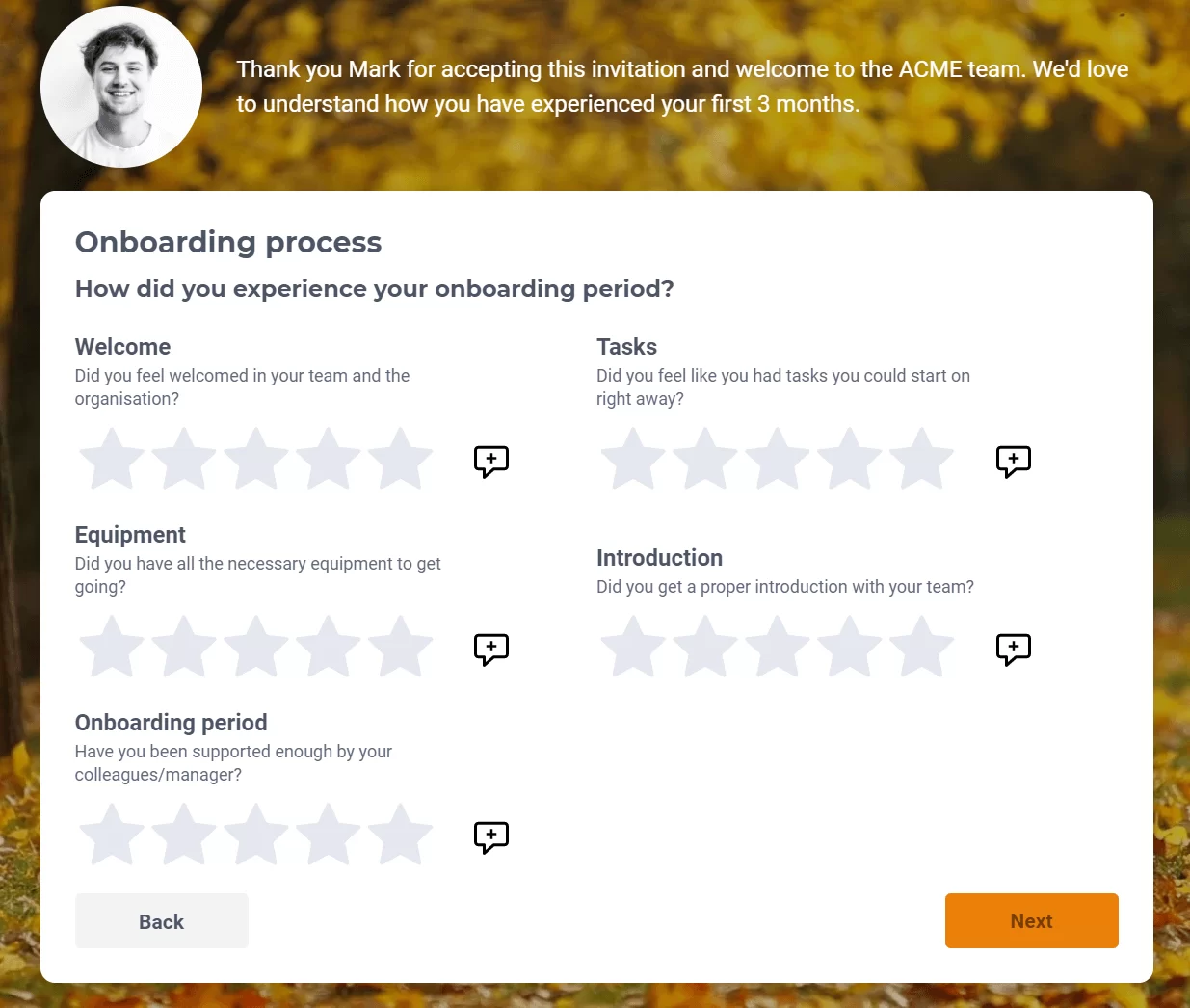Onboarding is a two-way street. It’s not just about delivering the right training and information, but also about how your new employee receives it. With the right survey, you’ll be able to measure the new hire experience and get valuable insights into how to build a strong relationship with your employees going forward.
What does a positive onboarding experience look like?
Employee onboarding isn’t just about giving new hires a warm welcome and making a good impression on their first day. A great experience paves the way for career success. It reaffirms people’s decision to join your company and gives them the tools they need to navigate your organization and do their jobs.
When you hire someone, you trust the skills and expertise they’ll bring to the team. Expecting them to figure everything out by themselves as soon as you “close the deal” leaves their future to chance. Offering a comprehensive orientation training program is an investment in that future. It means you’re committed to helping employees unlock their full potential from the start.
A positive onboarding process engages your new talent and sets the tone for their experience going forward. Your training should be interactive and entertaining. It should use your best learning tech and design. And, to ensure you’re achieving those goals, it should also rely on onboarding feedback.
Good data is invaluable to measuring the success of your program. But getting useful feedback can pose some challenges.
Onboarding challenges: Why is it hard to get new hire feedback?
Getting helpful input on your onboarding program isn’t always straightforward. New talent unfamiliar with your company or culture can have a hard time giving you useful insights for a couple of key reasons:
- They’re primed to see the best in their experience. New hires usually come in with a positive, go-getter attitude, so they may struggle to find flaws in the process.
- They can’t know what they don’t know. These employees are just embarking on a new career in a new company. They won’t necessarily know until after they have some experience on the job what would have made their onboarding experience better.
- They want to make a good impression, too. New hires might worry they could come across as “grumpy” or “arrogant” if they make any negative comments, so are more likely to hesitate to disclose areas for improvement.
While there may be challenges, you can still get some valuable feedback from your recent hires. You just have to make sure you focus your survey to gather data that matters.

Building a helpful onboarding survey
To get a complete picture of how successful your employee onboarding is, you need to focus on the who, what, when, and how of the survey process.
Who should you survey?
Who should you ask about the success of the process? Obviously, you want to hear from the employees who go through onboarding training.
But you can also learn a lot about how well onboarding is going by surveying their managers. Find out what they’re seeing on the job to gauge whether the content from the training is transferring to actual work results.
What should you ask?
What information would help you see whether you need to improve your onboarding experience? You’ll get a lot of insight by focusing on how well prepared the employee feels for their job after their onboarding training.
Elena Galli, content and social media marketer at Starred, a candidate and employee experience platform, shares some ideas about what to ask:
“Your questions should focus on whether your new hires have received sufficient attention from their managers, if they collaborate well with their colleagues, and if they feel like they get to contribute to the team.”
“You can also ask how satisfied they are with the training and growth opportunities you provide them with, if there are clear expectations about the targets they need to reach, and if they have all the necessary tools to pursue them,” she adds.
Here are some examples of questions you can include in an onboarding survey:
- How well do you understand your role and responsibilities?
- How confident are you in using the systems required by your role?
- How well does the training you’ve received apply to your job?
- How closely has your experience in the job aligned with your expectations?
- How well do you feel the company values align with your own?
- How satisfied are you that you understand how your role contributes to the organization’s objectives?
- What could we do to improve the onboarding experience?
The questions can include a scale so employees can rank their experience (for example, a scale from 1 to 5 where 1= “not at all” and 5= “extremely”). You may also want to include open-ended questions like the last one in the list above. This allows employees to give you feedback on things you might not have asked about directly but that impacted their experience.
When should you reach out?
The timeframe for when to survey people is another crucial factor in determining how helpful your survey will be. If you ask onboarding survey questions too soon, employees may not be able or feel comfortable enough in their role yet to share concerns. Responses may be limited or inaccurate. But waiting too long won’t leave you enough time to fix things and address concerns.
The key is to send surveys out at major milestones. It can be helpful to gather some onboarding feedback immediately after training sessions. You’ll also find value in checking in with employees after they’ve been on the job for a while and had time to apply what they’ve learned. This should be a set time, something like 30, 60, or 90 days after the hiring date.
How should you deliver the survey?
There are a number of ways to reach out to new employees about how their onboarding went. Use the delivery method that works best for your purposes. For example, you might include mini-quizzes, embedded in your LMS, after each course or training session. This will help you gauge whether new hires found that particular content useful and interesting.
Or, you can send polls via email at set times after the training to gauge how things are going as people settle into the job. A survey template, Elena says, could save you time, as you won’t have to create a questionnaire from scratch every time you want to gather onboarding feedback. Also, it’ll help you collect answers in a consistent way and identify patterns easily.

You may also integrate onboarding survey questions with other employee feedback, like an annual 360 review. This can help you see how engaged new employees are further down the road and give you a chance to assess any gaps in their training.
Using survey feedback
Gathering new hire feedback is a great first step in understanding what’s going well. But you can’t leave it at that. To improve your training, you’ll need to know how to analyze and act on the feedback you get.
Here are two tips for doing so:
1. Identify patterns
The most obvious needs for change will show up in the trends in the data. For example, if you’re regularly seeing employees report that they don’t understand HR processes, you’ll know to review and revamp that section of your training.
Also, look for trends by department. If you see consistently low scores in accounting around how training aligned with the software they use, you may want to revisit the part of your onboarding. For example, you might need to upgrade the content to more specifically illustrate how to use this software.
2. Look for change over time
Watch for whether employees maintain the level of engagement they report during onboarding. If you see engagement scores falling in subsequent surveys or through annual reviews, it can be an indicator that your training isn’t preparing people for their actual jobs. They may feel confident following an engaging orientation process but run into problems they’re not prepared for later down the road.
Again, new hires don’t always know what they don’t know. Checking in with them after they’ve spent time in their roles can reveal gaps in your onboarding training. And uncovering these gaps gives you the chance to make adjustments.
Support employee success with regular feedback
While surveys are a great way to collect data consistently, feedback shouldn’t be limited to a formal process. An onboarding survey is a great way to highlight where your process and training can be improved. But there’s a lot of value in keeping the communication lines open.
You can continue to learn about what’s working by making time for less structured conversations, whether in person or via real-time virtual meetings.
When you work to maintain a culture of transparency, you show people that you’re invested in their employee experience. You also help both new and current employees feel comfortable opening up about that experience. And you in turn can improve processes and build a better workplace.



